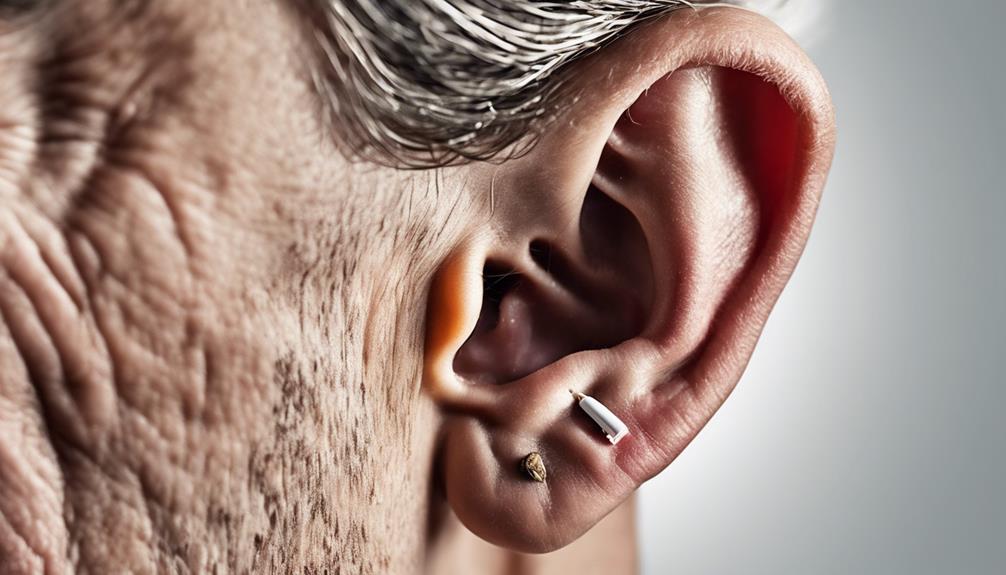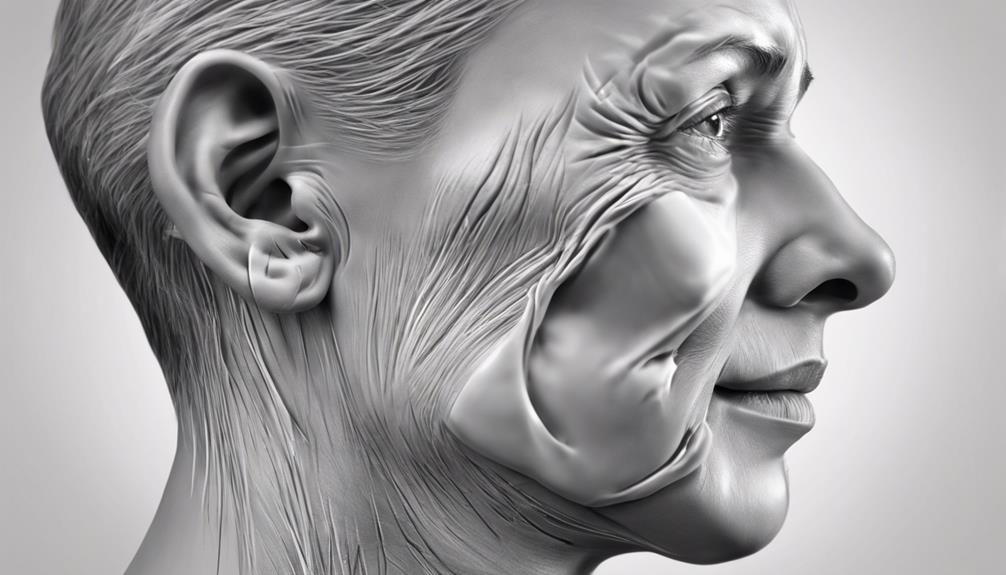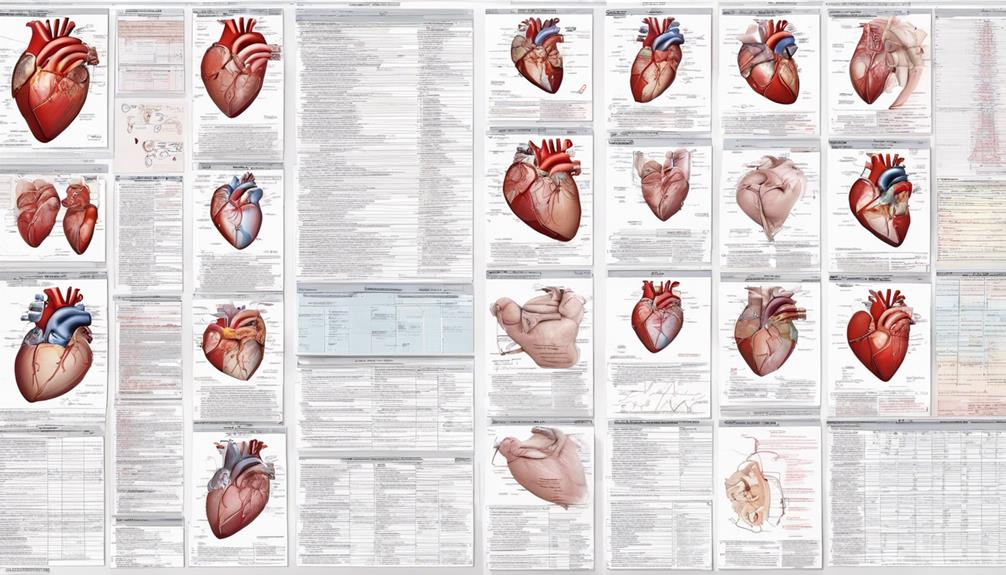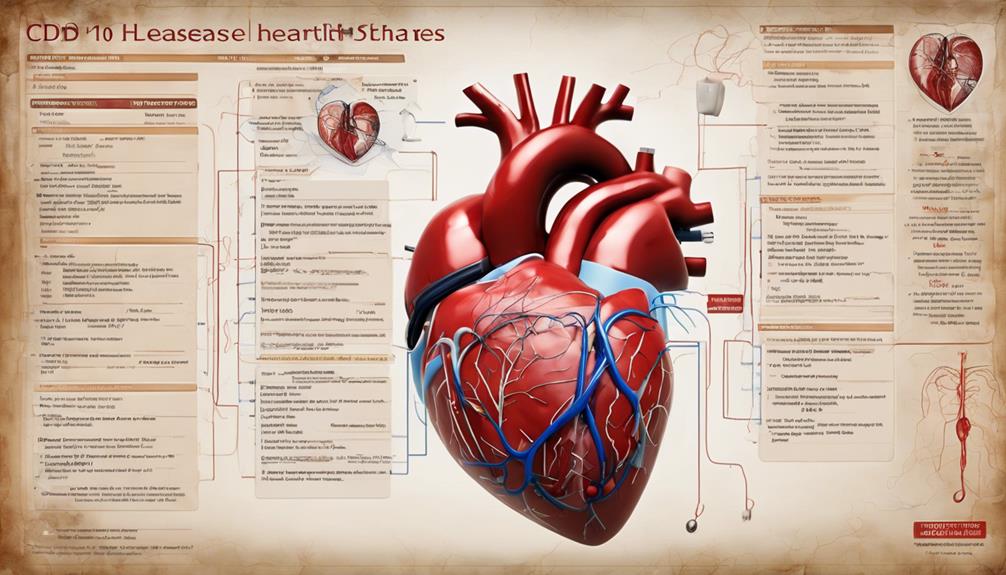Investigating the fascinating link between an ear crease and heart disease unveils a distinct relationship between physical traits and cardiovascular health.
While the link between this subtle ear characteristic and vascular conditions has captured the curiosity of researchers and healthcare professionals alike, questions linger about its precise predictive value and potential clinical implications.
Join us on this journey through the enigmatic realm of Frank's Sign, where the ears may hold secrets to the heart's well-being that are yet to be fully revealed.
Key Takeaways
- Diagonal earlobe creases are significantly associated with coronary artery disease (CAD).
- Ear creases serve as independent predictors of CAD risk.
- Understanding risk factors crucial for identifying individuals at higher CAD risk.
- Collaboration with healthcare providers enhances CAD management outcomes.
Understanding the Link Between Ear Crease and Heart Health
Understanding the correlation between ear creases and heart health is crucial in identifying individuals at higher risk for cardiovascular diseases. Specifically, the presence of diagonal earlobe creases (DELC) has been significantly associated with an increased risk of coronary artery disease (CAD) and atherosclerotic vascular disease. Studies have demonstrated that DELC serves as an independent predictor of CAD risk, alongside factors such as age, gender, and smoking status. Furthermore, the predictive value of DELC extends beyond CAD, as its presence may also indicate a predisposition to ischemic cerebrovascular events like stroke and impact the outcomes of CAD interventions.
The association between earlobe creases and heart disease isn't merely coincidental. The pathophysiology underlying the development of earlobe creases involves processes such as oxidative stress, loss of elastic fibers, and alterations in blood vessel thickness. These changes contribute to the association between ear creases and CAD, shedding light on the potential role of ear examination in assessing cardiovascular risk factors.
Risk Factors Associated With Crease in Ear Heart Disease

In examining the risk factors associated with crease in ear heart disease, research highlights a significant correlation between diagonal earlobe creases (DELC) and increased susceptibility to coronary artery disease (CAD). Studies have shown that individuals with a DELC may have a higher prevalence of CAD and peripheral vascular disease, making DELC an independent variable for CAD risk, particularly when combined with other cardiovascular risk factors.
The presence of DELC has been linked to predicting adverse outcomes in CAD and ischemic cerebrovascular events. The pathophysiology of the association between DELC and CAD involves alterations in specific proteins and hormones, contributing to the development of atherosclerosis. Understanding these risk factors is crucial for identifying individuals at higher risk for CAD and implementing preventive strategies to reduce the incidence of adverse cardiovascular events linked to diagonal earlobe creases.
Diagnosis and Detection of Ear Crease Sign
The diagnostic evaluation of the ear crease sign involves assessing its potential as a marker for coronary artery disease (CAD) and peripheral vascular disease. Research indicates that the presence of a diagonal earlobe crease (DELC) can be an independent predictor of CAD, particularly when considered alongside other cardiovascular risk factors.
Here are key points to consider:
- DELC may correlate with the severity of CAD and the likelihood of experiencing adverse cardiovascular events.
- Dermatologists observing DELC can prompt further assessment by primary care physicians to evaluate potential cardiovascular comorbidities.
- Studies have explored the diagnostic accuracy of DELC in identifying chronic coronary syndromes.
- While DELC shows promise as a potential indicator, its definitive role as a standalone marker for CAD is still being investigated.
Understanding the significance of the ear crease sign in relation to CAD can aid in the early detection and management of cardiovascular conditions, highlighting the importance of a multidisciplinary approach in addressing cardiovascular health concerns.
Management and Prevention Strategies

Effective management and prevention of coronary artery disease (CAD) necessitates comprehensive lifestyle modifications and adherence to prescribed medications for optimal outcomes.
Medications play a crucial role in controlling CAD progression by lowering cholesterol levels and preventing blood clots. Lifestyle changes, including adopting a heart-healthy diet, engaging in regular exercise, and quitting smoking, are essential in preventing complications associated with CAD.
Regular monitoring of blood pressure, cholesterol levels, and blood sugar is vital for managing CAD and reducing cardiovascular risks. Additionally, collaborating with healthcare providers to develop personalized treatment plans tailored to individual needs can significantly enhance CAD management outcomes.
In some cases, interventional procedures or surgery may be necessary to address severe CAD. By focusing on lifestyle modifications, medication adherence, and proactive monitoring, individuals can effectively manage CAD and improve their overall heart health.
Research and Future Directions
Exploring the potential link between earlobe creases and cardiovascular risk factors has opened avenues for further research into identifying novel markers for coronary artery disease. Dermatologists can play a crucial role in utilizing earlobe creases as a prompt for evaluating and facilitating early diagnosis of certain conditions associated with cardiovascular risk.
While studies have shown varying results regarding the diagnostic accuracy of earlobe creases in detecting chronic coronary syndromes, their presence may slightly alter the pre-test probability for such syndromes. It's essential to note that reliance solely on earlobe creases for guiding clinical management isn't recommended.
Research has delved into the association between earlobe creases and cardiovascular risk factors across diverse patient populations. Furthermore, autopsy studies have investigated earlobe creases to unravel their pathophysiological basis and potential clinical implications in the context of cardiovascular diseases.
Moving forward, future directions should focus on enhancing the understanding of the role of earlobe creases in early diagnosis and management strategies for coronary artery disease.
Frequently Asked Questions
Is Ear Crease Linked to Heart Disease?
Yes, ear creases have been linked to heart disease. Studies suggest a potential association between diagonal earlobe creases and an increased risk of coronary artery disease.
Research indicates that recognizing this ear feature, in conjunction with other visible signs, could aid in the early detection of cardiovascular issues like CAD.
Individuals with diagonal earlobe creases may face a higher susceptibility to adverse cardiovascular events, emphasizing the importance of considering such visible markers in clinical assessments.
What Is the Ear Sign of Heart Disease?
The ear sign of heart disease, known as Frank's Sign or Diagonal Earlobe Crease (DELC), has been associated with various vascular diseases. Studies link it to coronary artery disease, peripheral vascular disease, and cerebrovascular disease.
The presence of this sign is more common in patients with a history of coronary bypass surgery and has been linked to cardiovascular events in hospitalized patients. The exact pathophysiology of the ear sign is still unclear.
How Accurate Is the Frank's Sign?
When it comes to the accuracy of Frank's Sign in predicting CAD, we've got a solid foundation of evidence to rely on. Various research studies have consistently shown that the presence of Frank's Sign can indeed serve as an independent variable for CAD risk.
This reliability makes it a valuable indicator of subclinical atherosclerosis, aiding in the early diagnosis of CAD. The data speaks for itself in highlighting the significance of Frank's Sign in assessing cardiovascular health.
What Does a Crease in Your Ear Mean?
Having a crease in the ear can sometimes indicate underlying health concerns. It's essential to recognize that this physical feature may be linked to various vascular diseases.
Understanding the potential implications of an ear crease can aid in early detection and management of associated conditions. Regular monitoring and assessment of such visible markers can be crucial in assessing overall health and potentially preventing more serious health issues down the line.
Conclusion
In conclusion, the crease in the ear, known as Frank's Sign, serves as a potential indicator of underlying cardiovascular issues. While the exact mechanism remains unclear, its presence warrants further investigation and consideration in clinical practice.
By recognizing and addressing this subtle yet significant marker, healthcare professionals can potentially enhance early detection and management of heart disease. Stay vigilant, for even the smallest signs can hold valuable clues to our cardiovascular health.









